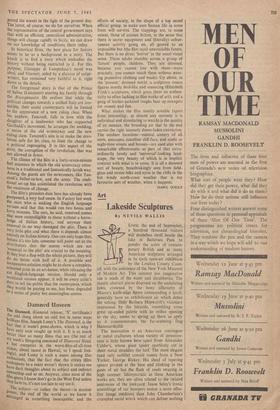Damned Unseen
The Damned. (General release; 'X' certificate.) AN odd thing about an odd but in some ways brilliant film, Joseph Losey's The Damned, is the fact that it wasn't press-shown, which is why I have only now caught up with it. It is so much better than so many films that are (the rest of mY week's filmgoing consisted of Diamond Head, 't hot competer in the worst-film-of-all-time stakes, about incest in Hawaii, so I speak feel- ingly), and Losey is such a name among film enthusiasts, that the fact that the critics (film enthusiasts to a man) weren't shown it makes me have dark thoughts about its subject and indirect censorship and so on. Anyway, since most of the film-goers I know don't go in the West End unless they have to, it's not too late to say see it. The subject—or rather the theme—is nuclear power, the end of the world as we know it envisaged as something inescapable; and the
efforts of society, in the shape of a top secret official group, to make sure human life in some form will survive. The trappings are, to some extent, those of science fiction, in the sense that there is secret equipment and (literally) subter- ranean activity going on, all geared to an impossible but (the film says) unavoidable future. But there is no direct 'horror' in the usual visual sense. Three adults stumble across a group of 'future' people, children. They are doomed, because you cannot live with them—more precisely, you cannot touch them without wear- ing protective clothing and masks. Up above, in the 'present,' doomed world, a sculptress makes figures mostly bird-like and menacing (Elizabeth Frink's sculptures, which gives them an authen- ticity so often lacking in film works of art); and a gang of leather-jacketed toughs beat up strangers for money and fun.
What makes the film mostly notable (apart from interesting: at almost any moment it is individual and stimulating to watch) is the quality of its menace, the brooding air that in the end carries the right intensely doom-laden conviction. The outdoor locations—natural scenery of all sorts, seascapes, coastline cliff-face, and sunlit or night-time streets and houses—are used also with remarkable effectiveness as part of that extra- ordinarily lovely and `universal'-looking land- scape, the very beauty of which is in implicit contrast with what is to come. It is all a damned sort of beauty, breathtakingly seen from field- glass and motor-bike and eyrie in the cliffs in the hot windy south-coast weather that is my favourite sort of weather, when it happens.
ISABEL QUIGLY










































 Previous page
Previous page